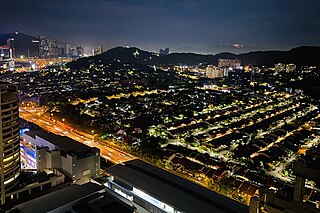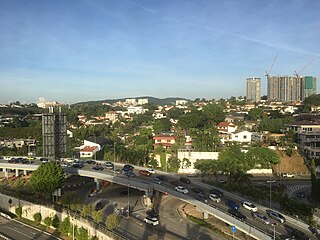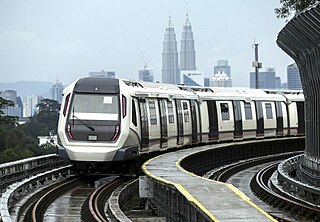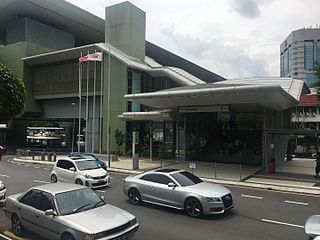
Kajang is a town in Hulu Langat District, Selangor, Malaysia, located southeast of Kuala Lumpur. Kajang, along with much of Hulu Langat District, is governed by the Kajang Municipal Council. Kajang town is located on the eastern banks of the Langat River. It is surrounded by Cheras, Semenyih, Bangi, Putrajaya and Serdang.

Bangsar is a residential suburb on the outskirts of Kuala Lumpur, lying about 4 kilometres (2.5 mi) south-west of the city centre. It is part of the Lembah Pantai parliamentary constituency. Bangsar is administered by Dewan Bandaraya Kuala Lumpur (DBKL), unlike other townships in the Klang Valley such as Petaling Jaya and Subang Jaya which have their municipal councils. Neighbourhood residents' associations and business councils play a part in communicating with the local authority, but they exercise no legal or administrative power. Malays make up most of the population at 61%, followed by the Chinese at 24%, Indians at 15%.

The Bakun Dam is an embankment dam located in Belaga District, Kapit Division, Sarawak, Malaysia, on the Balui River, a tributary or source of the Rajang River and some sixty kilometres east of Belaga. As part of the project, the second-tallest concrete-faced rockfill dam in the world would be built. It would generate 2,400 megawatts (MW) of electricity once completed.

SPRINT ExpresswaySprint Expressway(Malay: Sistem Penyuraian Trafik Kuala Lumpur Barat, English: System of Traffic Dispersal in Western Kuala Lumpur) is the main expressway network in Klang Valley, Malaysia. The 26.5 km (16.5 mi) expressway is divided into three sections: the Kerinchi Link, Damansara Link and Penchala Link. It is a three-lane dual carriageway that was built to disperse traffic from congested inner city roads and narrow residential streets leading into Kuala Lumpur from the western suburbs, including Petaling Jaya, Damansara, and surrounding areas. It is one of the busiest expressway during rush hour to and from the city centre.

Yong Pung How was a Malayan-born Singaporean judge who served as the second chief justice of Singapore between 1990 and 2006.
Duta–Ulu Klang Expressway, is the main expressway network in Klang Valley, Malaysia. The 18 km (11 mi) expressway connects New Klang Valley Expressway's Jalan Duta Interchange (E1) to Taman Hillview Interchange on Kuala Lumpur Middle Ring Road 2 28 in Ulu Klang. The expressway was constructed to provide the "missing link" between New Klang Valley Expressway (E1), Kuala Lumpur–Karak Expressway (E8), and Kuala Lumpur Middle Ring Road 2 (JKR28). This expressway is also known as the Kuala Lumpur Northeast Dispersal Link Scheme. It was proposed by Tan Sri Datuk Lim Kang Hoo, a chairman of Ekovest Berhad.

Mont Kiara, often stylized as Mont' Kiara and MK, is an affluent suburb at the northwest of downtown Kuala Lumpur, Malaysia, in the constituency of Segambut. It consists mainly of high-rise residential condominiums and office complexes which were mostly developed by UEM Sunrise Berhad, a well-known property development arm of UEM Group. It is located in the heart of Klang Valley, halfway between Kepong and downtown Kuala Lumpur. It is adjacent to Sri Hartamas in the south and KL Metropolis in the east, and is heavily populated by expats.

Taman Tun Dr Ismail is a mid-sized township in Kuala Lumpur, Malaysia. Situated on the border of Kuala Lumpur and Selangor, it is within the vicinity of other townships including Bandar Utama Damansara, Damansara Utama, Mutiara Damansara. It also neighbours Bukit Kiara and Sri Hartamas and is within easy access of Bangsar and Damansara Heights. This township is in the Federal Territory of Kuala Lumpur with Kuala Lumpur City Hall (DBKL) as its local authority. It is primarily a residential neighborhood with businesses ranging from retail shops, restaurants and offices. Menara Ken and Plaza VADS are the two high-rise office buildings in TTDI. The township was named after Tun Dr. Ismail bin Abdul Rahman, Malaysia's first ambassador to the United States and a Malaysian representative to the United Nations, before becoming Malaysia's Deputy Prime Minister in 1970. Taman Tun Dr. Ismail is often abbreviated as "TTDI".

The People's Plaza is an under construction mixed-use skyscraper complex in Kuala Lumpur, Malaysia initiated during the 1990s. However the project, which had already commenced construction, stalled due to the 1997 Asian financial crisis until 2020 and is currently revived by DBKL.

Segambut is a sub-district in Kuala Lumpur, Malaysia. The federal constituency represented in the Dewan Rakyat is Segambut.

Wangsa Maju is a township and a constituency in Kuala Lumpur, Malaysia. This area is surrounded by Setapak, Taman Melati and Gombak district in Selangor. Wangsa Maju is one of the major suburbs in Kuala Lumpur.

Damansara Heights is an upscale suburb in western side of Kuala Lumpur, Malaysia, located five kilometres away from the city centre. The suburb falls under the Segambut district and its parliamentary constituency. It is a sought-after residential and commercial address in Klang Valley.
Mentakab is a town, a mukim (commune) and a state assembly constituency in Temerloh District in central Pahang, Malaysia. It is 9 km (5.6 mi) northwest from downtown Temerloh and 82 km (51 mi) northeast from Kuala Lumpur.

The MRT Kajang Line, previously known as the MRT Sungai Buloh–Kajang Line, is a Mass Rapid Transit (MRT) line servicing the Klang Valley, Malaysia. It is the second fully automated and driverless rail system in the Klang Valley region after the LRT Kelana Jaya Line. Owned by MRT Corp and operated as part of the Rapid KL system by Rapid Rail, it forms part of the Klang Valley Integrated Transit System. The line is numbered 9 and coloured green on official transit maps.

1Malaysia Development Berhad is an insolvent Malaysian strategic development company, wholly owned by the Minister of Finance (Incorporated).

The Istana Negara is the official residence of the Yang di-Pertuan Agong. It is located along Jalan Tuanku Abdul Halim near Taman Duta, northwestern Kuala Lumpur. The palace opened in 2011 and replaced the old Istana Negara which was located at a different compound in central Kuala Lumpur.

The following lists events from 2015 in Malaysia.

The Semantan MRT Station is a mass rapid transit (MRT) station that serves the suburb of Damansara Heights, Kuala Lumpur, Malaysia. It is one of the stations on the MRT Kajang Line and was opened on 16 December 2016 when Phase One of the line became operational.
The Malaysian federal budget for 2015 fiscal year was presented to the Dewan Rakyat by Prime Minister and Minister of Finance, Najib Razak on Friday, 10 October 2014.
Taman Sri Sinar is a township in Kuala Lumpur, Malaysia. It is located in the northwest of the Segambut constituency and is surrounded by Taman Sri Bintang, Segambut Jaya, Taman Seri Kepong Baru, Taman Bukit Segambut, Taman Segambut Aman and Taman Segambut Damai. It has an estimated population of 40,000 as of 2010. This township is in the Federal Territory of Kuala Lumpur with Kuala Lumpur City Hall (DBKL) as its local authority.
















